Performance Improvement of Glass Microfiber Based Thermal Transpiration Pump Using TPMS
Abstract
:1. Introduction
2. The Modeling of Thermal Transpiration Membrane
3. Experimental Setup
3.1. Apparatus
3.2. Boundary Conditions of Thermal Transpiration Membrane Simulation
3.3. TPMS Structures and Fabrication
4. Results and Discussion
4.1. Thermal Transpiration Membrane without TPMS
4.2. Thermal Transpiration Membrane with TPMS
4.3. The Effect of TMPS Structure and Pumping Performance
4.4. The Effect of Relative Density on Thermal Transpiration Membrane Performance
5. Discussion and Conclusions
Author Contributions
Funding
Acknowledgments
Conflicts of Interest
Appendix A

| Minimum Mesh Size (mm) | Total Number of Elements | Flow Rate (mL/min) | Difference in Flow Rate from the Previous Iteration |
|---|---|---|---|
| 1.0 | 412,650 | 18.8909 | - |
| 0.8 | 441,598 | 18.8908 | 0.0006% |
| 0.5 | 515,843 | 18.8927 | 0.0097% |
| 0.3 | 610,046 | 18.8924 | 0.0015% |
| 0.2 | 789,356 | 18.8939 | 0.0078% |
References
- Regmi, B.P.; Agah, M. Micro gas chromatography: An overview of critical components and their integration. Anal. Chem. 2018, 90, 13133–13150. [Google Scholar] [CrossRef] [PubMed]
- Liao, W.; Zhao, X.; Lu, H.-T.; Byambadorj, T.; Qin, Y.; Gianchandani, Y.B. Progressive Cellular Architecture in Microscale Gas Chromatography for Broad Chemical Analyses. Sensors 2021, 21, 3089. [Google Scholar] [CrossRef] [PubMed]
- Rhodes, B.L.; Ronney, P.D. Thermal Transpiration Applied to Small Satellite Propulsion. In Proceedings of the AIAA Propulsion and Energy 2020 Forum, Virtual Event, 24–28 August 2020; p. 3813. [Google Scholar]
- Kugimoto, K.; Hirota, Y.; Yamauchi, T.; Yamaguchi, H.; Niimi, T. Design and demonstration of Knudsen heat pump without moving parts free from electricity. Appl. Energy 2019, 250, 1260–1269. [Google Scholar] [CrossRef]
- Zeng, P.; Wang, K.; Ahn, J.; Ronney, P.D. Technology, Thermal transpiration based pumping and power generation devices. J. Therm. Sci. Technol. 2013, 8, 370–379. [Google Scholar] [CrossRef]
- Seo, J.; Lim, H.-S.; Park, J.; Park, M.R.; Choi, B.S. Development and experimental investigation of a 500-W class ultra-micro gas turbine power generator. Energy 2017, 124, 9–18. [Google Scholar] [CrossRef]
- Tanaka, S.; Nakai, T.; Toriyama, T. Analysis of aerodynamic performance of high-speed rotational components for MEMS based turbomachinery considering effects of tip clearance and diabatic heat transfer. Electron. Commun. Jpn. 2021, 104, e12326. [Google Scholar] [CrossRef]
- Reynolds, O. On certain dimensional properties of matter in the gaseous state. Philos. Trans. R. Soc. Lond. 1879, 170, 727–845. [Google Scholar]
- Zhao, S.; Jiang, B.; Maeder, T.; Muralt, P.; Kim, N.; Matam, S.K.; Jeong, E.; Han, Y.-L.; Koebel, M.M. Dimensional and structural control of silica aerogel membranes for miniaturized motionless gas pumps. ACS Appl. Mater. Interfaces 2015, 7, 18803–18814. [Google Scholar] [CrossRef]
- Zito, P.F.; Caravella, A.; Brunetti, A.; Drioli, E.; Barbieri, G. Discrimination among gas translation, surface and Knudsen diffusion in permeation through zeolite membranes. J. Membr. Sci. 2018, 564, 166–173. [Google Scholar] [CrossRef]
- Nakaye, S.; Sugimoto, H.; Gupta, N.K.; Gianchandani, Y.B. Thermally enhanced membrane gas separation. Eur. J. Mech.-B/Fluids 2015, 49, 36–49. [Google Scholar] [CrossRef]
- Nolte, S.; Fink, R.; Krooss, B.M.; Amann-Hildenbrand, A.; Wang, Y.; Wang, M.; Schmatz, J.; Klaver, J.; Littke, R. Experimental investigation of gas dynamic effects using nanoporous synthetic materials as tight rock analogues. Transp. Porous Media 2021, 137, 519–553. [Google Scholar] [CrossRef]
- Wongwiwat, J.; Bhuripanyo, P.; Welles, T.; DeBiase, V.; Ahn, J.; Ronney, P. Thermally Self-Sustaining Tubular SOFC Power Generator with No Moving Parts. J. Phys. Conf. Ser. 2019, 1407, 012007. [Google Scholar] [CrossRef]
- Neuhöfer, A.M.; Herrmann, K.; Lebeda, F.; Lauster, T.; Kathmann, C.; Biehs, S.A.; Retsch, M. High-Temperature Thermal Transport in Porous Silica Materials: Direct Observation of a Switch from Conduction to Radiation. Adv. Funct. Mater. 2022, 32, 2108370. [Google Scholar] [CrossRef]
- Wang, K.; Zeng, P.; Ahn, J.; Ronney, P.D. A self-sustaining thermal transpiration gas pump and SOFC power generation system. Proc. Combust. Inst. 2013, 34, 3327–3334. [Google Scholar] [CrossRef]
- Sone, Y.; Itakura, E.J.S. Analysis of Poiseuille and thermal transpiration flows for arbitrary Knudsen numbers by a modified Knudsen number expansion method and their database. Shinku 1990, 33, 92–94. [Google Scholar] [CrossRef]
- Sone, Y.; Kataoka, T.; Ohwada, T.; Sugimoto, H.; Aoki, K.J.E. Numerical examination of applicability of the linearized Boltzmann equation. Eur. J. Mech. B Fluids 1994, 13, 573–589. [Google Scholar]
- Muntz, E.; Sone, Y.; Aoki, K.; Vargo, S.; Young, M.J.J. Performance analysis and optimization considerations for a Knudsen compressor in transitional flow. J. Vac. Sci. Technol. A Vac. Surf. Film. 2002, 20, 214–224. [Google Scholar] [CrossRef]
- Ye, J.; Shao, J.; Hao, Z.; Salem, S.; Zhang, Y.; Wang, Y.; Li, Z. Characteristics of thermal transpiration effect and the hydrogen flow behaviors in the microchannel with semicircular obstacle. Int. J. Hydrogen Energy 2019, 44, 29724–29732. [Google Scholar] [CrossRef]
- Ye, J.; Shao, J.; Xie, J.; Zhao, Z.; Yu, J.; Zhang, Y.; Salem, S. The hydrogen flow characteristics of the multistage hydrogen Knudsen compressor based on the thermal transpiration effect. Int. J. Hydrogen Energy 2019, 44, 22632–22642. [Google Scholar] [CrossRef]
- Zhu, L.; Guo, Z.J.C. Application of discrete unified gas kinetic scheme to thermally induced nonequilibrium flows. Comput. Fluids 2019, 193, 103613. [Google Scholar] [CrossRef]
- Sugimoto, S.; Sugimoto, H.J.A.A. Driving mechanism of thermal transpiration pump with porous material. AIP Adv. 2020, 10, 105007. [Google Scholar] [CrossRef]
- Du, C.; Wang, X.; Han, F.; Ren, X.; Zhang, Z. Numerical Investigation into the Flow Characteristics of Gas Mixtures in Knudsen Pump with Variable Soft Sphere Model. Micromachines 2020, 11, 784. [Google Scholar] [CrossRef]
- Zhang, Z.; Wang, X.; Zhao, L.; Zhang, S.; Zhao, F. Study of flow characteristics of gas mixtures in a rectangular Knudsen pump. Micromachines 2019, 10, 79. [Google Scholar] [CrossRef] [PubMed]
- Cheng, Q.; Qin, Y.; Gianchandani, Y.B. A bidirectional Knudsen pump with a 3D-printed thermal management platform. Micromachines 2021, 12, 58. [Google Scholar] [CrossRef] [PubMed]
- Broughton, J.; Joshi, Y.K.J.J. Comparison of single-phase convection in additive manufactured versus traditional metal foams. J. Heat Transf. 2020, 142, 082201. [Google Scholar] [CrossRef]
- Teng, F.; Sun, Y.; Guo, S.; Gao, B.; Yu, G. Topological and Mechanical Properties of Different Lattice Structures Based on Additive Manufacturing. Micromachines 2022, 13, 1017. [Google Scholar] [CrossRef] [PubMed]
- Spear, D.G.; Palazotto, A.N. Investigation and Statistical Modeling of the Mechanical Properties of Additively Manufactured Lattices. Materials 2021, 14, 3962. [Google Scholar] [CrossRef] [PubMed]
- Meeks, W.H., III. The theory of triply periodic minimal surfaces. Indiana Univ. Math. J. 1990, 39, 877–936. [Google Scholar] [CrossRef]
- Han, L.; Che, S. An overview of materials with triply periodic minimal surfaces and related geometry: From biological structures to self-assembled systems. Adv. Mater. 2018, 30, 1705708. [Google Scholar] [CrossRef]
- Jin, M.; Feng, Q.; Fan, X.; Luo, Z.; Tang, Q.; Song, J.; Ma, S.; Nie, Y.; Jin, P.; Zhao, M. Investigation on the mechanical properties of TPMS porous structures fabricated by laser powder bed fusion. J. Manuf. Processes 2022, 76, 559–574. [Google Scholar] [CrossRef]
- Wong, M.; Owen, I.; Sutcliffe, C.; Puri, A.J.; Transfer, M. Convective heat transfer and pressure losses across novel heat sinks fabricated by Selective Laser Melting. Int. J. Heat Mass Transf. 2009, 52, 281–288. [Google Scholar] [CrossRef]
- Silva, E.C.; Sampaio, Á.M.; Pontes, A.J.J.M. Evaluation of Active Heat Sinks Design under Forced Convection—Effect of Geometric and Boundary Parameters. Materials 2021, 14, 2041. [Google Scholar] [CrossRef] [PubMed]
- Son, K.N.; Weibel, J.A.; Kumaresan, V.; Garimella, S.V. Design of multifunctional lattice-frame materials for compact heat exchangers. Int. J. Heat Mass Transf. 2017, 115, 619–629. [Google Scholar] [CrossRef]
- Ho, J.Y.; Leong, K.C.; Wong, T. Experimental and numerical investigation of forced convection heat transfer in porous lattice structures produced by selective laser melting. Int. J. Therm. Sci. 2019, 137, 276–287. [Google Scholar] [CrossRef]
- Kaur, I.; Singh, P.J.N.H.T. Part A: Applications, Flow and thermal transport characteristics of Triply-Periodic Minimal Surface (TPMS)-based gyroid and Schwarz-P cellular materials. Numer. Heat Transf. Part A Appl. 2021, 79, 553–569. [Google Scholar] [CrossRef]
- Al-Ketan, O.; Ali, M.; Khalil, M.; Rowshan, R.; Khan, K.A.; Abu Al-Rub, R.K. Forced convection computational fluid dynamics analysis of architected and three-dimensional printable heat sinks based on triply periodic minimal surfaces. J. Therm. Sci. Eng. Appl. 2021, 13, 021010. [Google Scholar] [CrossRef]
- Qureshi, Z.A.; Al-Omari, S.A.B.; Elnajjar, E.; Al-Ketan, O.; Al-Rub, R.A. Using triply periodic minimal surfaces (TPMS)-based metal foams structures as skeleton for metal-foam-PCM composites for thermal energy storage and energy management applications. Int. Commun. Heat Mass Transf. 2021, 124, 105265. [Google Scholar] [CrossRef]
- Oh, S.-H.; Ha, J.-W.; Park, K. Adaptive Conformal Cooling of Injection Molds Using Additively Manufactured TPMS Structures. Polymers 2022, 14, 181. [Google Scholar] [CrossRef]
- Li, W.; Yu, G.; Yu, Z. Bioinspired heat exchangers based on triply periodic minimal surfaces for supercritical CO2 cycles. Appl. Therm. Eng. 2020, 179, 115686. [Google Scholar] [CrossRef]
- Kim, J.; Yoo, D.-J. Engineering, 3D printed compact heat exchangers with mathematically defined core structures. J. Comput. Des. Eng. 2020, 7, 527–550. [Google Scholar]
- Qu, S.; Ding, J.; Song, X. Achieving triply periodic minimal surface thin-walled structures by micro laser powder bed fusion process. Micromachines 2021, 12, 705. [Google Scholar] [CrossRef] [PubMed]
- Al-Ketan, O.; Abu Al-Rub, R.K. MSLattice: A free software for generating uniform and graded lattices based on triply periodic minimal surfaces. Mater. Des. Process. Commun. 2021, 3, e205. [Google Scholar] [CrossRef]
- Nicolaï, A.; Monti, J.; Daniels, C.; Meunier, V. Electrolyte Diffusion in Gyroidal Nanoporous Carbon. J. Phys. Chem. C 2015, 119, 2896–2903. [Google Scholar] [CrossRef]
- Poltue, T.; Karuna, C.; Khrueaduangkham, S.; Seehanam, S.; Promoppatum, P. Design exploration of 3D-printed triply periodic minimal surface scaffolds for bone implants. Int. J. Mech. Sci. 2021, 211, 106762. [Google Scholar] [CrossRef]
- Rathore, S.S.; Mehta, B.; Kumar, P.; Asfer, M. Flow Characterization in Triply-Periodic-Minimal-Surface (TPMS) based Porous Geometries: Part 1—Hydrodynamics. arXiv 2022, arXiv:2205.03591. [Google Scholar]

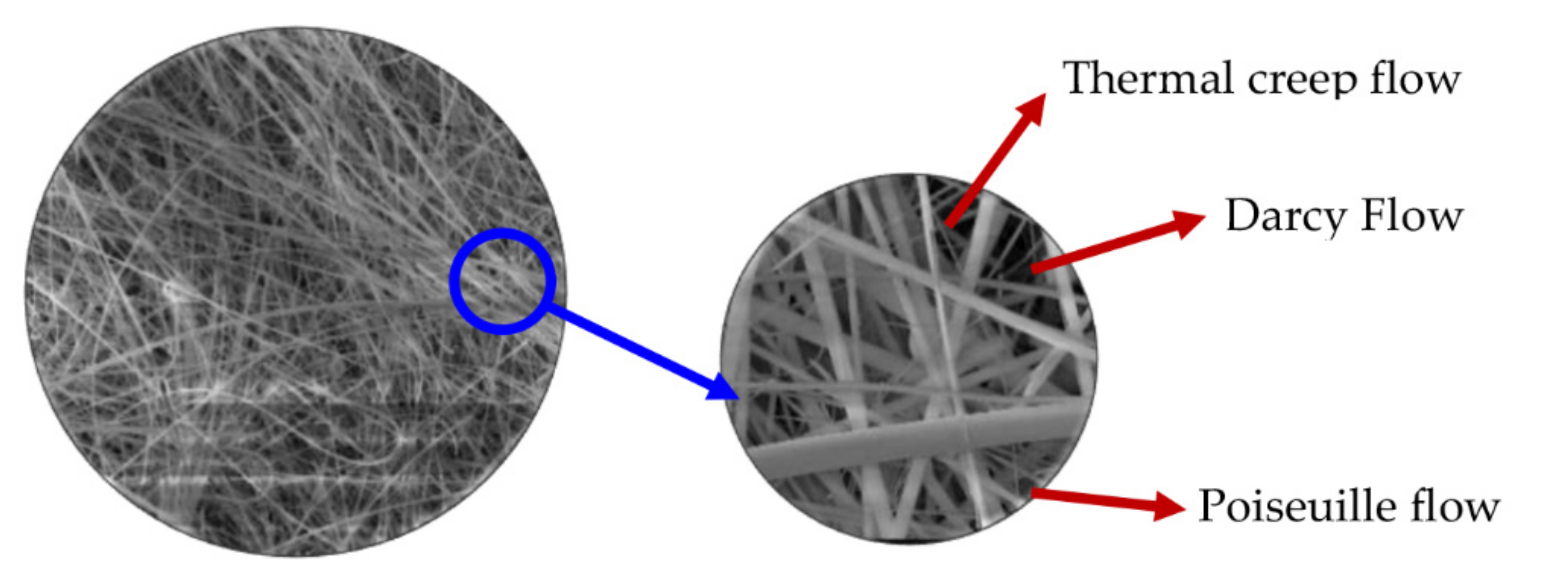
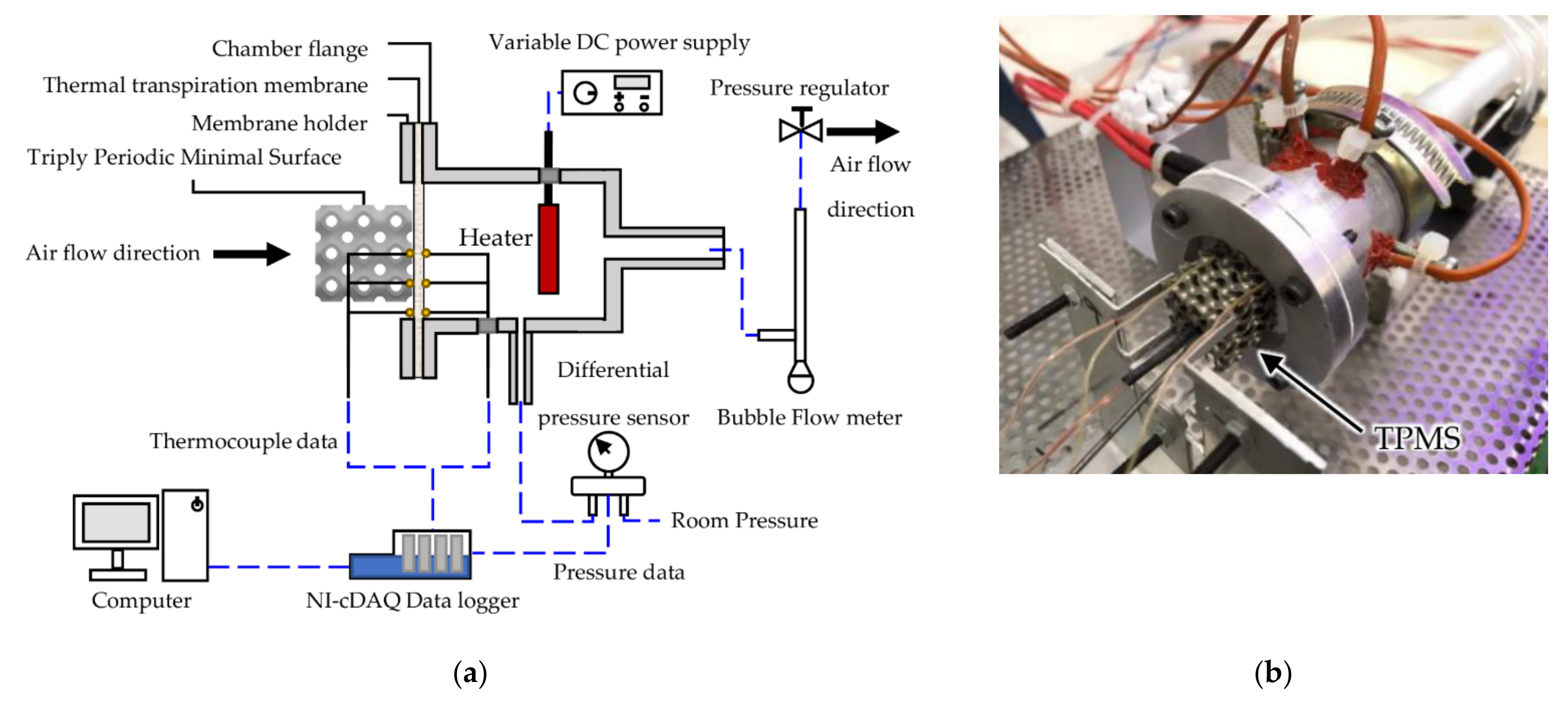
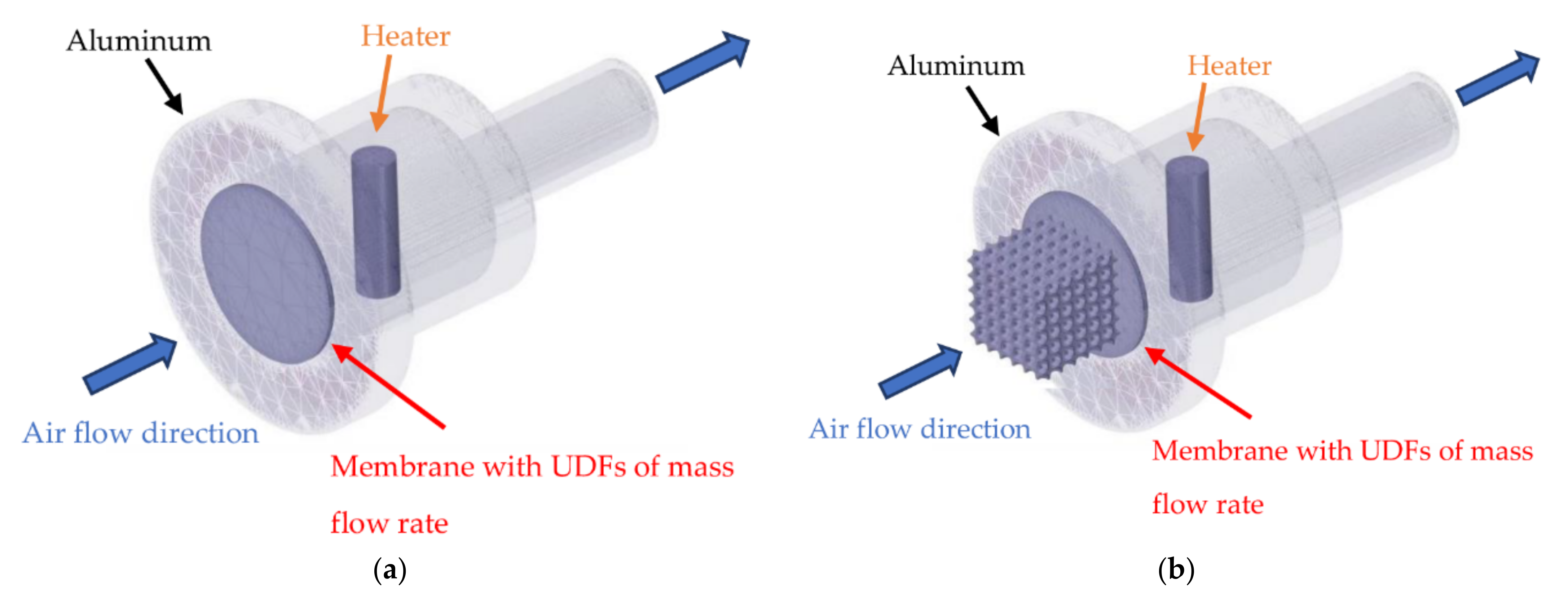
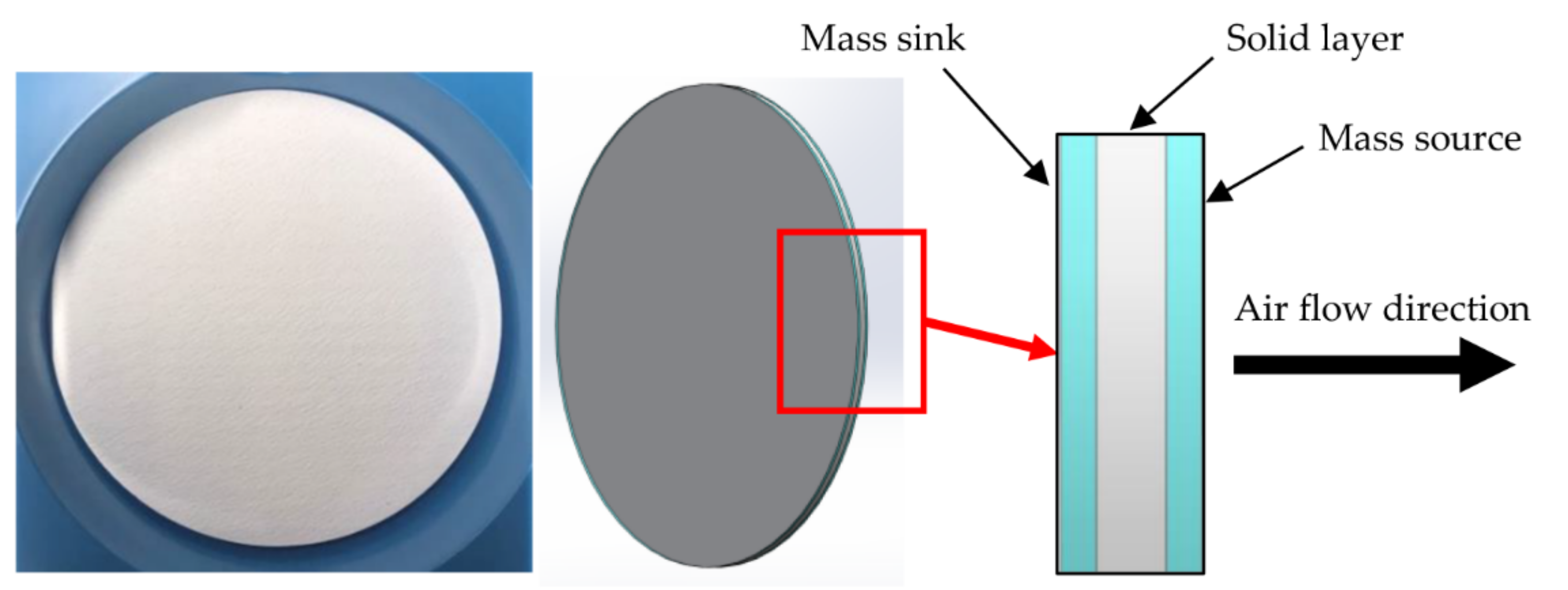
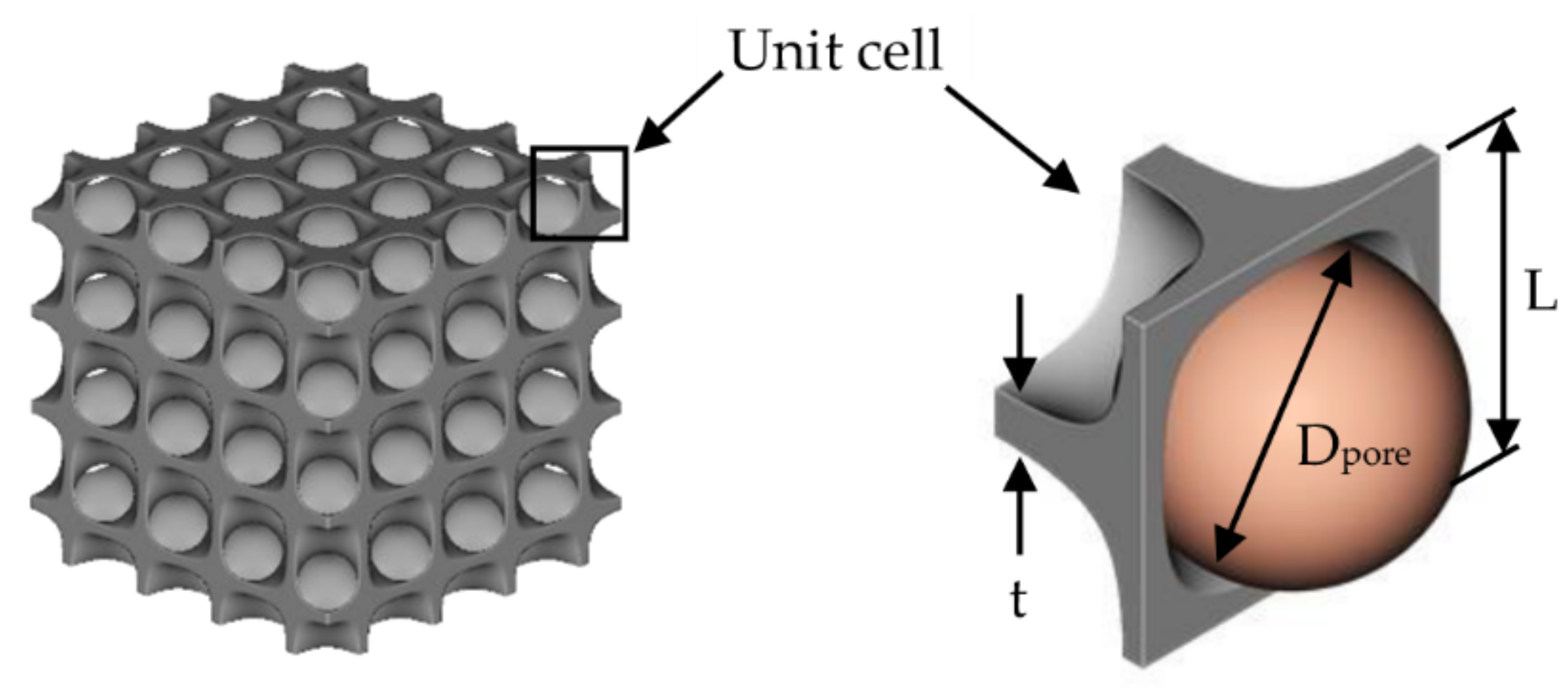

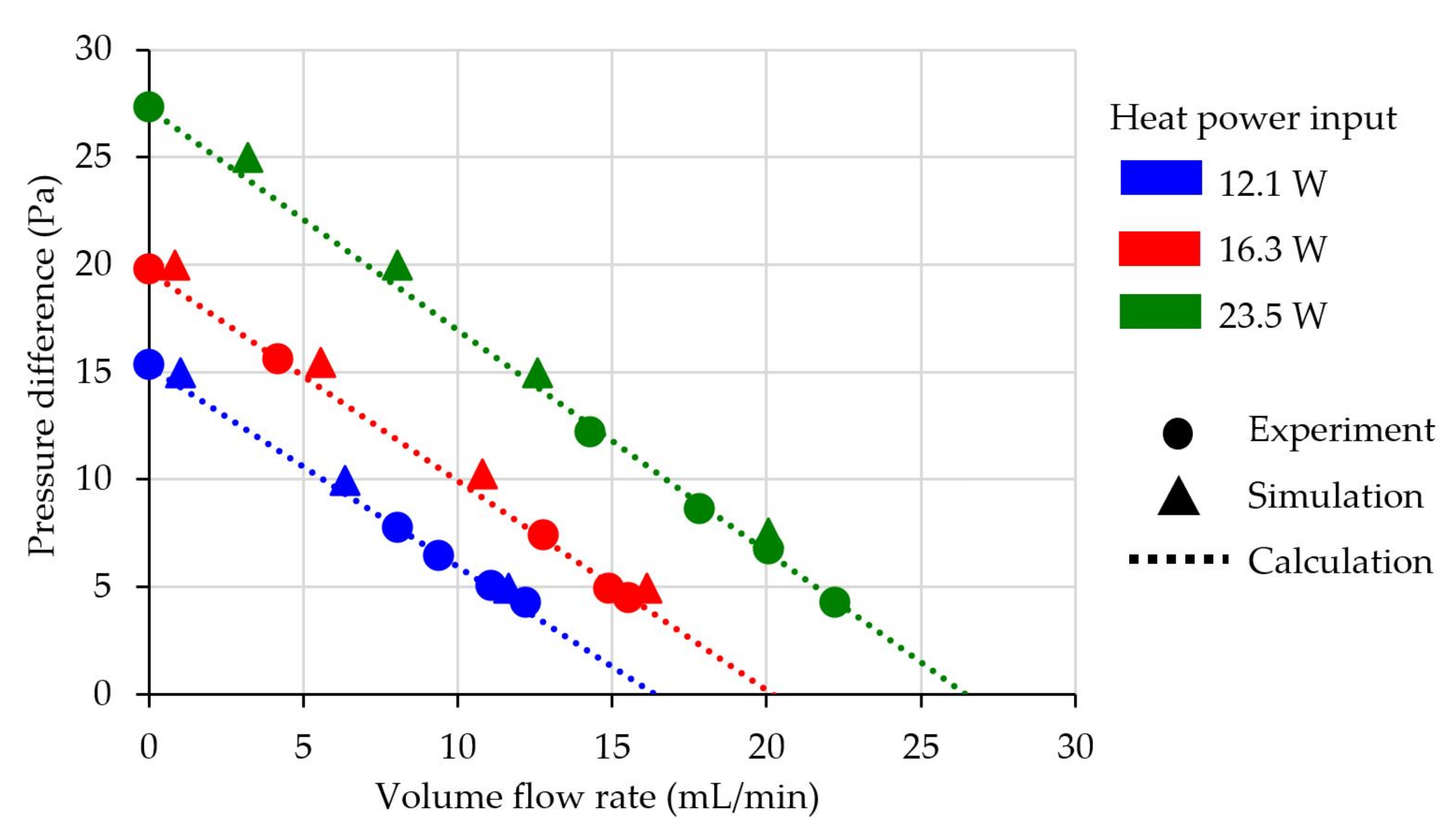

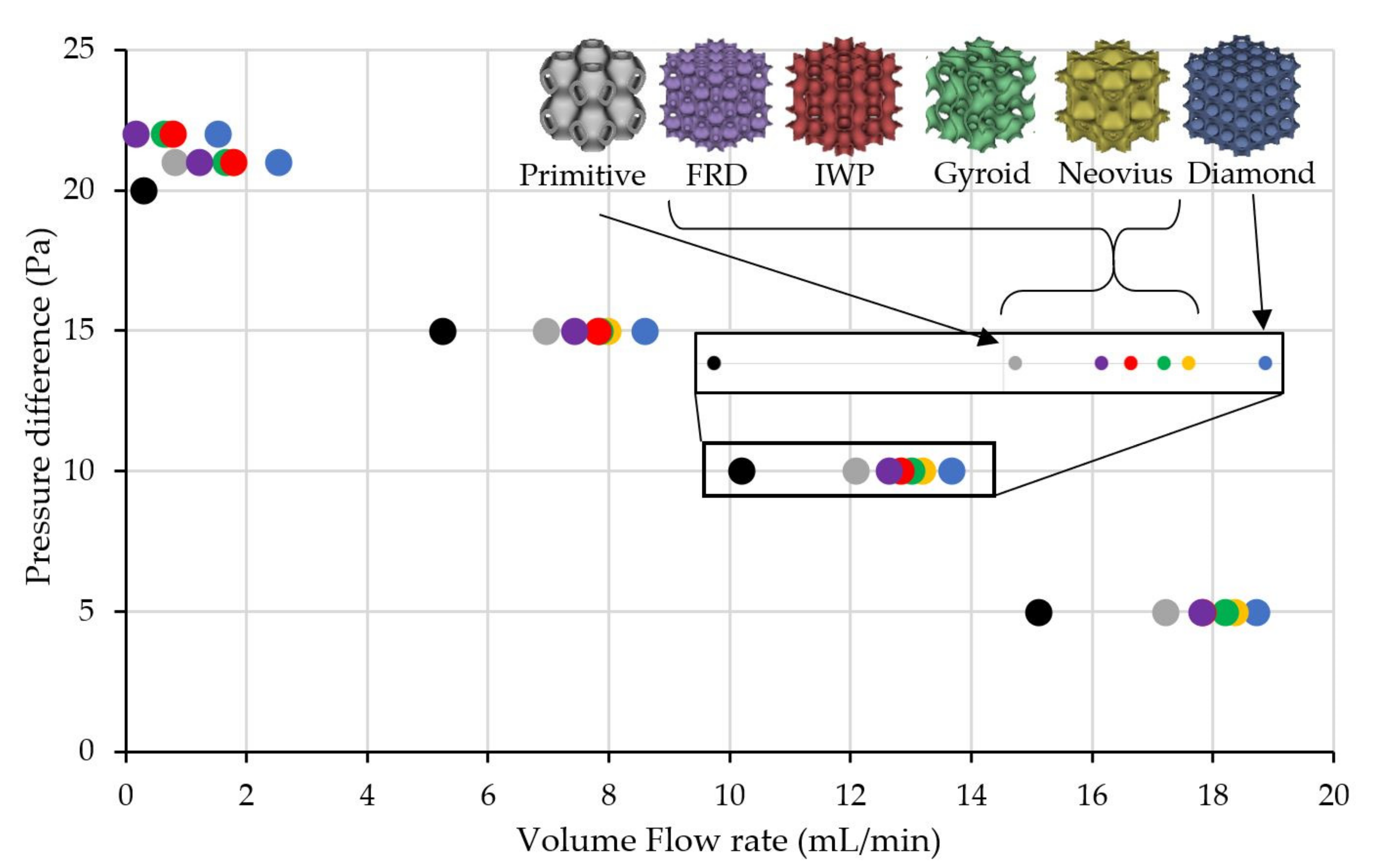

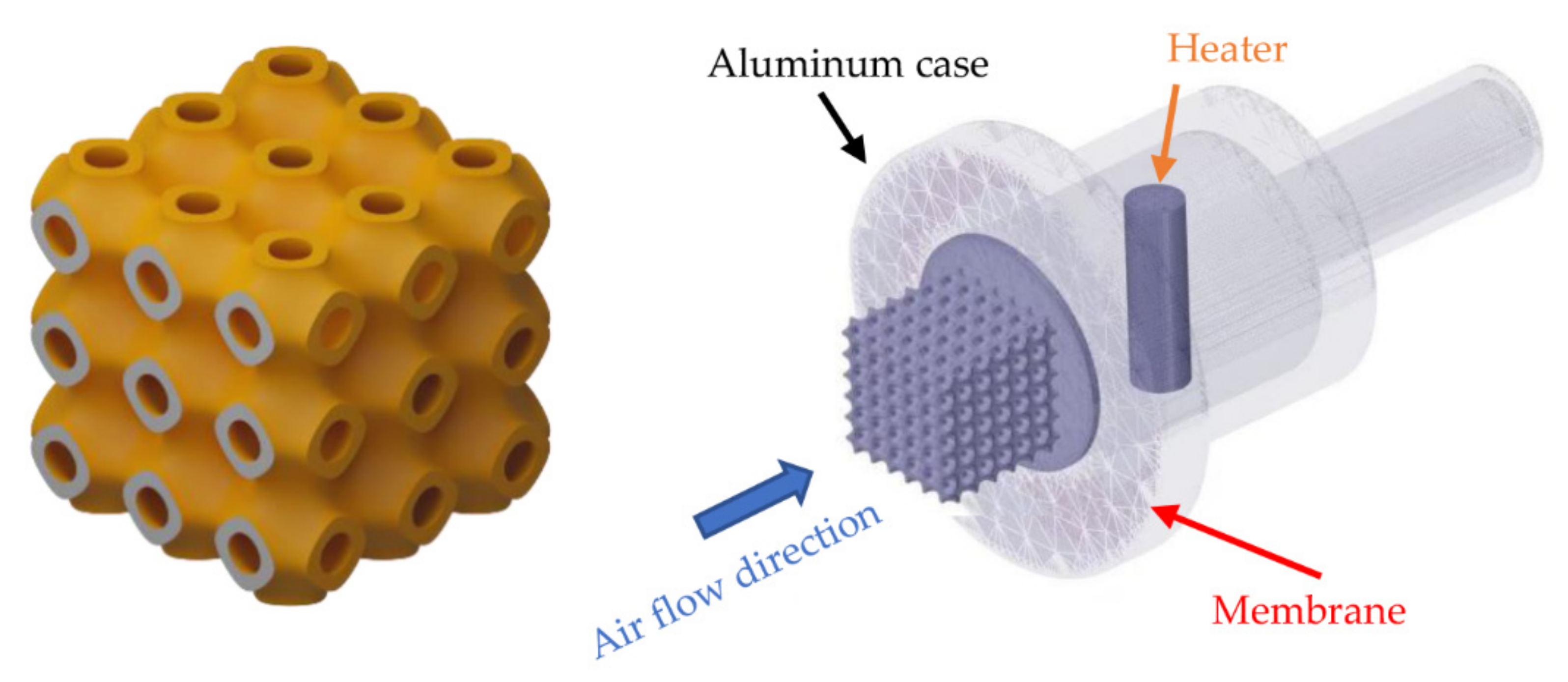
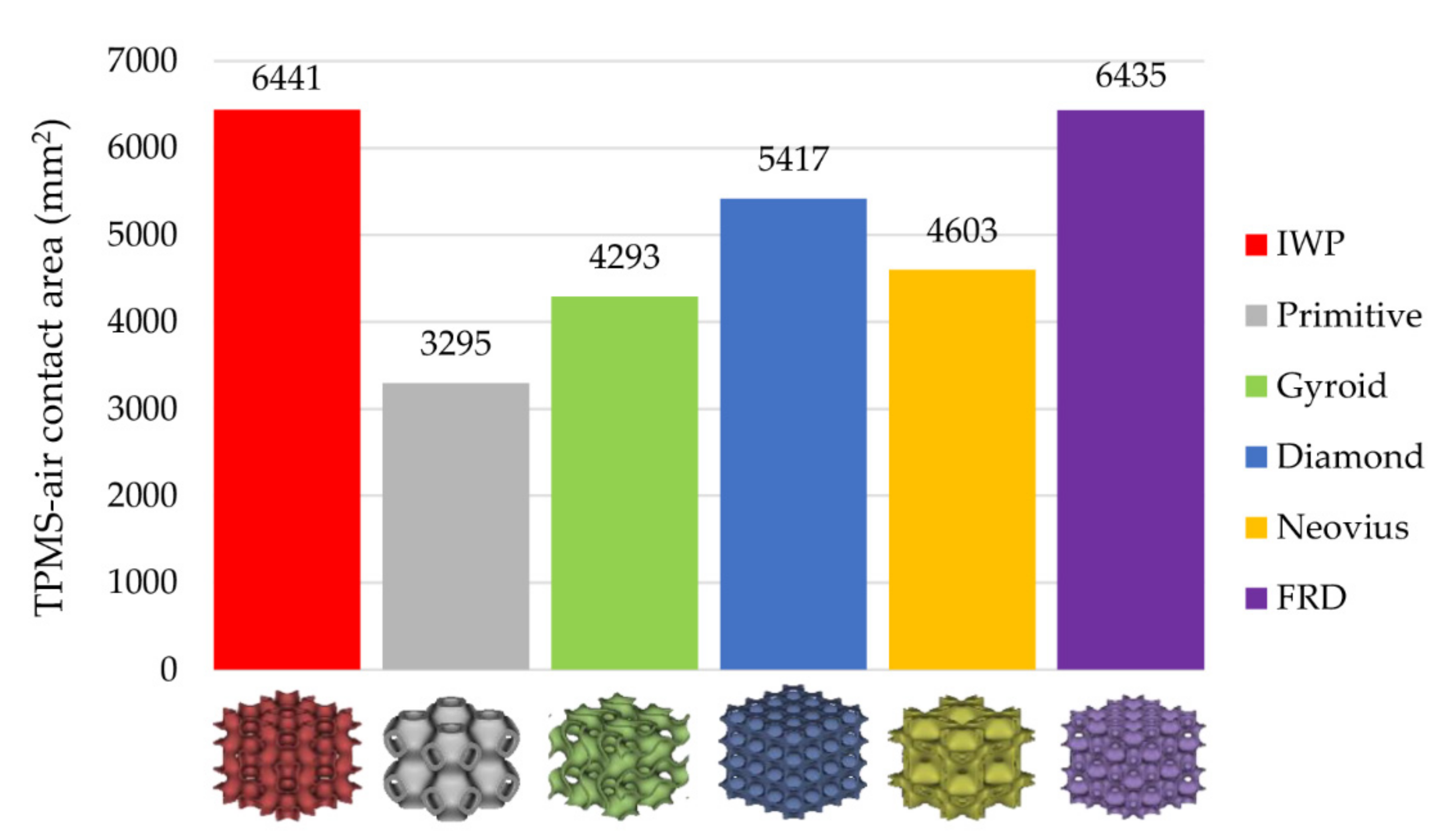
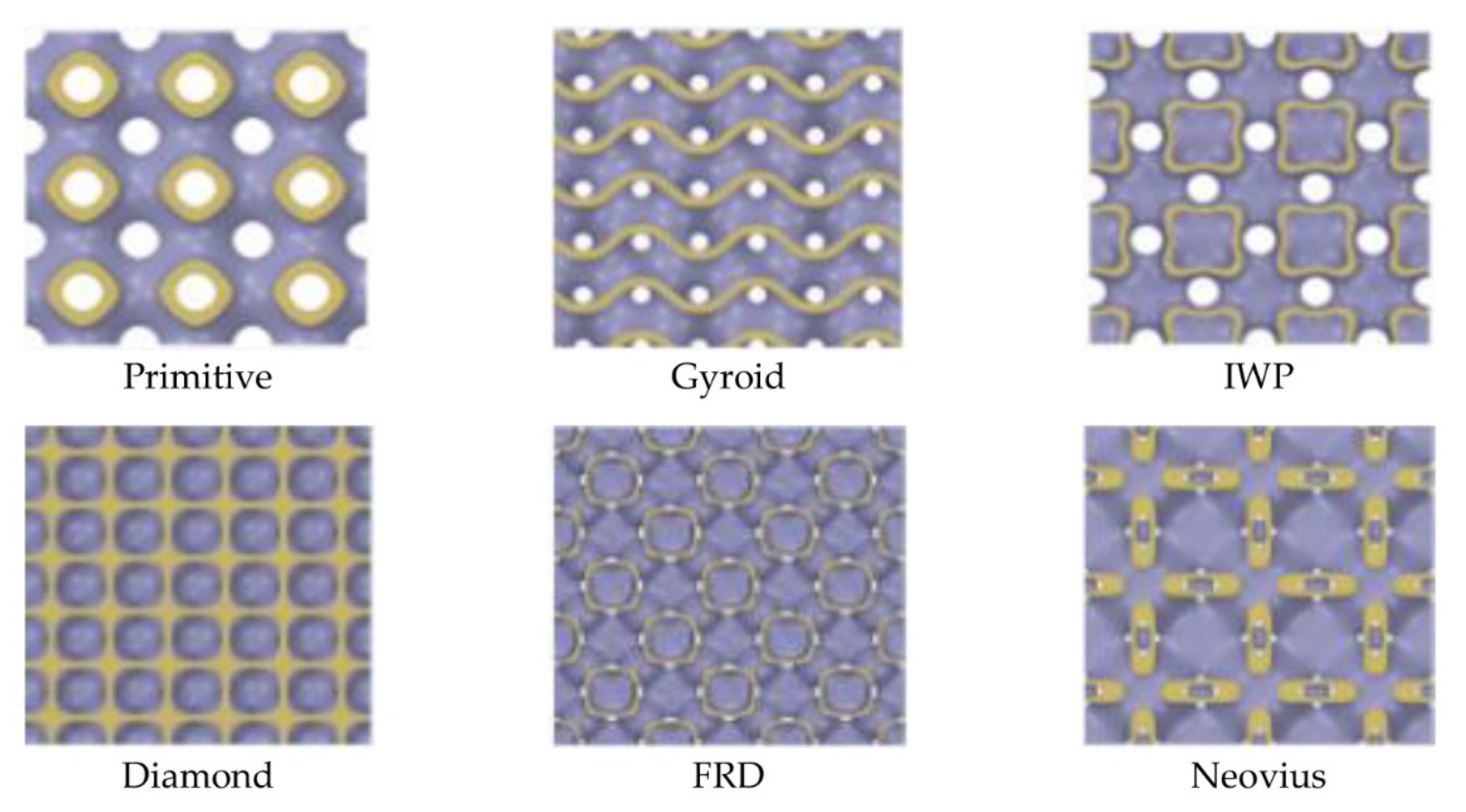



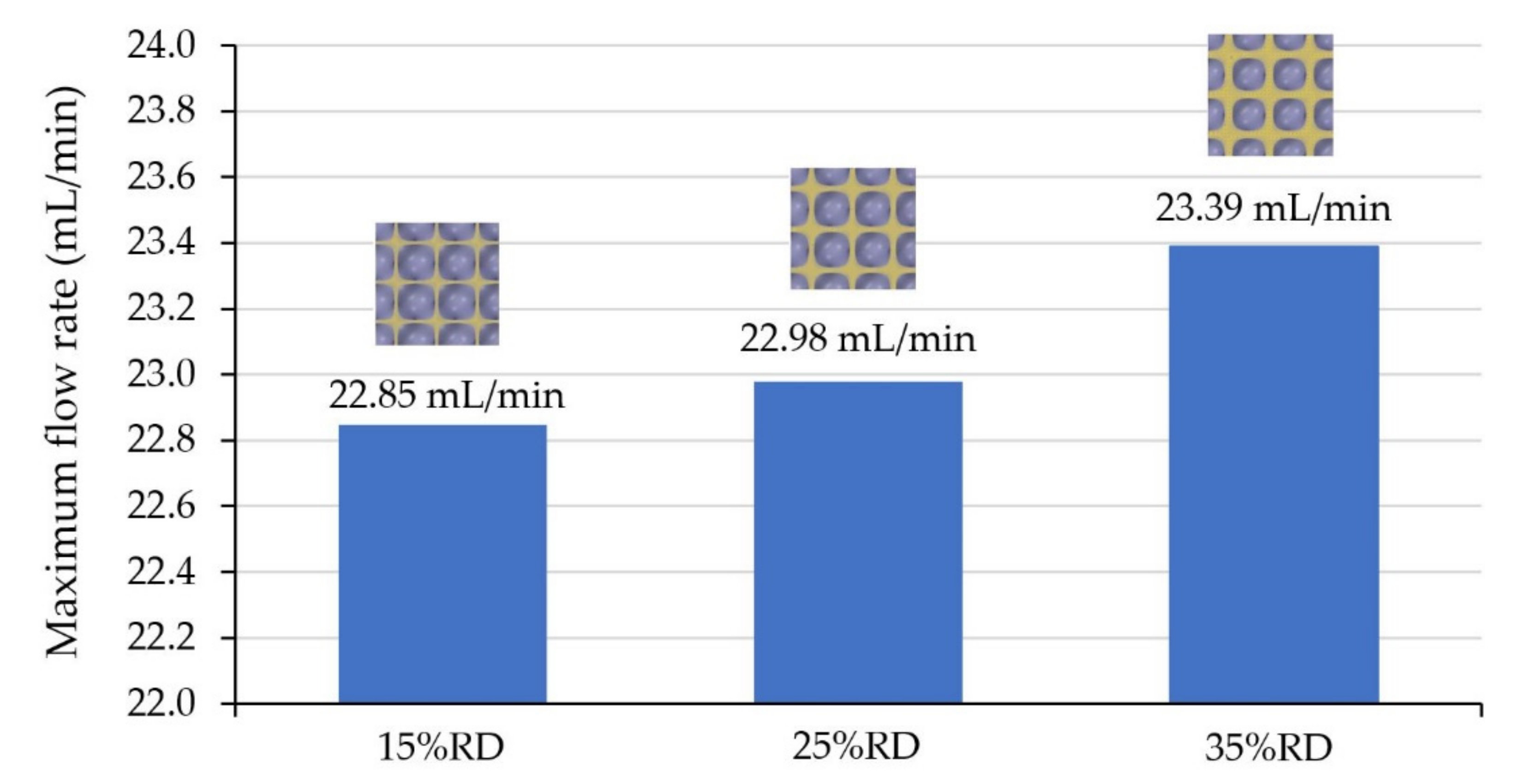
| TPMS | TPMS Equation | |
|---|---|---|
| IWP | 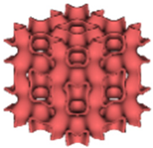 | |
| Primitive |  | |
| Gyroid |  | |
| Diamond |  | |
| Neovius |  | |
| FRD | 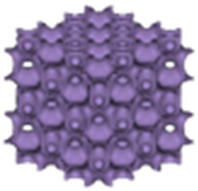 | |
Publisher’s Note: MDPI stays neutral with regard to jurisdictional claims in published maps and institutional affiliations. |
© 2022 by the authors. Licensee MDPI, Basel, Switzerland. This article is an open access article distributed under the terms and conditions of the Creative Commons Attribution (CC BY) license (https://creativecommons.org/licenses/by/4.0/).
Share and Cite
Parittothok, P.; Poolwech, C.; Tanteng, T.; Wongwiwat, J. Performance Improvement of Glass Microfiber Based Thermal Transpiration Pump Using TPMS. Micromachines 2022, 13, 1632. https://doi.org/10.3390/mi13101632
Parittothok P, Poolwech C, Tanteng T, Wongwiwat J. Performance Improvement of Glass Microfiber Based Thermal Transpiration Pump Using TPMS. Micromachines. 2022; 13(10):1632. https://doi.org/10.3390/mi13101632
Chicago/Turabian StyleParittothok, Pitipat, Chanon Poolwech, Tanawit Tanteng, and Jakrapop Wongwiwat. 2022. "Performance Improvement of Glass Microfiber Based Thermal Transpiration Pump Using TPMS" Micromachines 13, no. 10: 1632. https://doi.org/10.3390/mi13101632
APA StyleParittothok, P., Poolwech, C., Tanteng, T., & Wongwiwat, J. (2022). Performance Improvement of Glass Microfiber Based Thermal Transpiration Pump Using TPMS. Micromachines, 13(10), 1632. https://doi.org/10.3390/mi13101632







